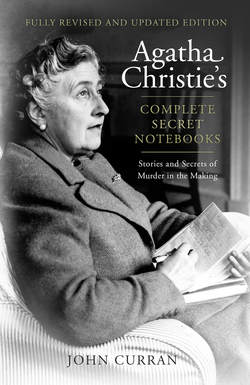Читать книгу Agatha Christie’s Complete Secret Notebooks - Агата Кристи, Agatha Christie, Detection Club The - Страница 23
… what I invariably do is lose the exercise book …
ОглавлениеIn a career spanning over half a century and two world wars, some loss is inevitable but reassuringly this seems to have happened hardly at all. Of course, we cannot be sure how many Notebooks there should be, but the 73 we still have are an impressive legacy.
Nevertheless, no notes or outlines exists for The Murder on the Links (1923), The Murder of Roger Ackroyd (1926), The Big Four (1927) or The Seven Dials Mystery (1929). From the 1920s we have notes only for The Mysterious Affair at Styles (1920), The Man in the Brown Suit (1924), The Secret of Chimneys (1925) and The Mystery of the Blue Train (1928). When we remember that The Murder of Roger Ackroyd was published just before Christie’s traumatic disappearance and subsequent divorce it is perhaps not surprising that these notes are no longer extant. The same applies to The Big Four, despite the fact that this episodic novel had appeared earlier as individual short stories. And there is nothing showing the genesis of the first adventure of Tommy and Tuppence in The Secret Adversary (1922); for the 1929 collection Partners in Crime, there are only sketchy notes. This is a particular disappointment as it might have given us an insight into the thoughts of Agatha Christie on her fellow crime writers, who are affectionately pastiched in this collection.
From the 1930s onwards, however, the only missing book titles are Murder on the Orient Express (1934), Cards on the Table (1936) and Murder is Easy (1939). This would seem to suggest that very few notebooks were, in fact, lost. Why notes for Murder is Easy are missing – apart from a passing reference in Notebook 66 – is a minor mystery when the notes for the novels on either side survive.
In some cases the notes are sketchy and consist of little more than a list of characters (Death on the Nile – Notebook 30). And some titles have copious notes: They Came to Baghdad (100 pages), Five Little Pigs (75 pages), One, Two, Buckle my Shoe (75 pages). Other titles outline the course of the finished book so closely that I am tempted to assume that there were earlier, rougher notes that have not survived. A case in point is Ten Little Niggers1 (aka And Then There Were None). In An Autobiography Dame Agatha remembers: ‘I had written the book Ten Little Niggers because it was so difficult to do that the idea fascinated me. Ten people had to die without it becoming ridiculous or the murderer becoming obvious. I wrote the book after a tremendous amount of planning.’ Unfortunately, none of this planning survives; what there is in Notebook 65 follows almost exactly the progress of the novel. It is difficult to believe that this would have been written straight on to the page with so few deletions or so little discussion of possible alternatives. Nor are there, unfortunately, any notes for her dramatisation of this famous story. For the rest of her career we are fortunate to have notes on all of the novels. In the case of most of the later titles the notes are extensive and detailed – and legible.
Fewer than 50 of almost 150 short stories are discussed in the pages of the Notebooks. This may mean that, for many of them, Christie typed directly on to the page without making any preliminary notes. Or that she worked on loose pages that she subsequently discarded. When she wrote the early short stories she did not consider herself a writer in the professional sense of the word. It was only after her divorce, and the consequent need to earn her living, that she realised that writing was now her ‘job’. So the earliest adventures of Poirot as published in 1923 in The Sketch magazine do not appear in the Notebooks at all, although there are, thankfully, detailed notes for her greatest Poirot collection, The Labours of Hercules. And many ideas that she sketched for short stories did not make it any further than the pages of the Notebooks (see ‘Unused Ideas’).
Two examples of Agatha Christie, the housekeeper. The heading ‘Wallingford’ on the lower one confirms that they are both lists of items to bring to or from her various homes.
There are notes on most of her stage work, including unknown, unperformed and uncompleted plays. There are only two pages each of notes for her most famous and her greatest play, Three Blind Mice (as it still was at the time of writing the notes) and Witness for the Prosecution respectively. But these are disappointingly uninformative, as they contain no detail of the adaptation, merely a draft of scenes without any of the usual speculation.
And there are many pages devoted to An Autobiography, her poetry and her Westmacott novels. Most of the poetry is of a personal nature as she often wrote a poem as a birthday present for family members. There are only 40 pages in total devoted to the Westmacott titles, mainly of quotations that might provide titles, and those for An Autobiography are, for the most part, diffuse and disconnected, consisting of what are little more than reminders to herself.
